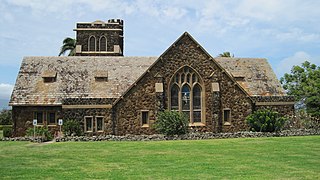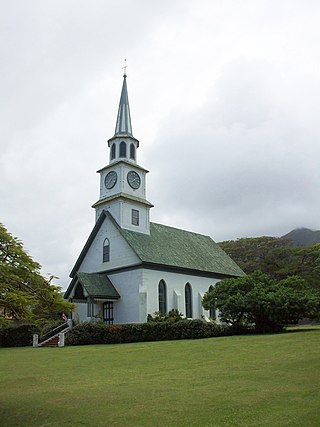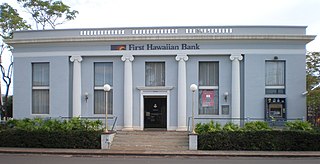
Kawaiahaʻo Church is a historic Congregational church located in Downtown Honolulu on the Hawaiian Island of Oʻahu. The church, along with the Mission Houses, comprise the Hawaiian Mission Houses Historic Site, which was designated a U.S. National Historic Landmark (NHL) in 1962. In 1966 it and all other NHLs were included in the first issuance of the National Register of Historic Places.

Washington Place is a Greek Revival palace in the Hawaii Capital Historic District in Honolulu, Hawaii. It was where Queen Liliʻuokalani was arrested during the overthrow of the Hawaiian Kingdom. Later it became the official residence of the governor of Hawaii. In 2007, it was designated as a National Historic Landmark. The current governor's residence was built in 2008 behind the historic residence, and is located on the same grounds as Washington Place.
At their peak, there were six Chinese Society Halls on Maui. Operated by the Gee Kung Tong Society, these halls were created to provide services to immigrant Chinese workers, mostly working for the sugarcane plantations. All provided religious and political help, in addition to mutual aid. Only the Wo Hing Society Hall in Lahaina and the Ket Hing Society Hall in Kula have survived. Both were placed on the Hawaii State Register of Historic Places on July 30, 1982, and placed on the National Register of Historic Places on November 15, 1982. The Chee Kung Tong Society Hall was placed onto both State and Federal registers, but collapsed in 1996.

Lahaina Historic District is a National Historic Landmark District encompassing most of the community of Lahaina, Hawaii, on the west side of the island of Maui in the US state of Hawaii. Designated in 1962, the district recognizes Lahaina for its well-preserved character as a 19th-century port, and for its social and economic importance in the 19th century as a major whaling center in the Pacific, and as one of the capital cities of the Kingdom of Hawaii.

Holy Ghost Catholic Church, also known as Holy Ghost Mission, is an historic octagon-shaped Roman Catholic church building on the island of Maui, located at 4300 Lower Kula Road in Waiakoa in the Kula district. It was designed by Father James Beissel and built by his parishioners who were Portuguese from the Azores and the Madeira Islands who had come to work on the local sugarcane plantation. The first mass was celebrated in it in 1895. It was consecrated in 1899 by Bishop Gulstan Ropert, the third vicar apostolic of the Vicariate Apostolic of the Sandwich Islands — now the Roman Catholic Diocese of Honolulu.

Mokuaikaua Church, located on the "Big Island" of Hawaii, is the oldest Christian church in the Hawaiian Islands. The congregation dates to 1820 and the building was completed in 1837.

Hōlualoa Bay is a historic area between Kailua-Kona and Keauhou Bay in the Kona District of the Big Island of Hawaiʻi. The community now called Hōlualoa is uphill from this bay. The name means "long slide" in the Hawaiian Language, from the long trail that went from a forest on the slopes of Hualālai, to a site where the logs were made into canoes into this bay where a large royal building complex was built over several centuries.

The Waiākea Mission Station was the first Christian mission on the eastern side of the Island of Hawaiʻi. Also known as the Hilo Station, the latest structure is now called Haili Church.

Waiola Church and Cemetery in Lāhainā is the site of a historic mission established in 1823 on the island of Maui in Hawaiʻi. Originally called Waineʻe Church until 1953, the cemetery is the final resting place for early members of the royal family of the Kingdom of Hawaii.

The Bond District is a collection of historic buildings located in the district of North Kohala on the island of Hawaii. The district has three sections: the homestead of missionaries Ellen and Reverend Elias Bond (1813–1896), Kalahikiola Church, and the Kohala Seminary.

Makawao Union Church is a church near Makawao on the Hawaiian island of Maui. It was founded by New England missionary Jonathan Smith Green during the Kingdom of Hawaii. The third historic structure used by the congregation was designed by noted local architect C.W. Dickey and dedicated in 1917 as the Henry Perrine Baldwin Memorial Church. In 1985, Makawao Union Church was placed on the Hawaii and National Register of Historic Places.

The Puʻunēnē School, also known as Puunene School, is a historic school building in the community of Puʻunēnē in the central part of Maui, Hawaii, United States. Built in 1922 by the Hawaiian Commercial and Sugar Company, which ran the community, it was erected on 10 acres (4.0 ha) of land donated by the company in 1913. Upon completion, it replaced an earlier four-room school on the site that was built to hold 350 students. The Classical Revival 1922 two-story concrete building became Maui's largest elementary school with about 1000 students. In the 1950s the area went into decline, and the building was used for special education classes. In 1979 it became an administrative annex for the Department of Education. It was added to the National Register of Historic Places listings in Hawaii on August 22, 2000.

Wailuku Elementary School is a public elementary school operated by the Hawaii Department of Education, occupying a historic school building in Wailuku, Hawaii.

Kaʻahumanu Church is a Church in Wailuku, Maui, Hawaii. Upon visiting a religious service in Wailuku in 1832 by Jonathan Smith Green, Queen Ka'ahumanu requested that a more permanent church structure be named for her, but her request was not honored until 1876 when the current structure was built by Edward Bailey. Sunday services are held in the church, with the hymns and invocation invoked in the Hawaiian language.

The Albert Spencer Wilcox Beach House was a home of Albert Spencer Wilcox. Located on Weke Road in Hanalei, Hawaii, it was listed on the Hawaiʻi Register of Historic Places in 1987 and on the National Register of Historic Places in 1993. It is a Folk Victorian-style building, with roofed lānai connecting the rooms. A 22-acre (8.9 ha) property, including five contributing buildings and four other contributing structures, was listed.

The Bishop National Bank of Hawaii was a bank in Hawaii. Its branch building on Hawaii Route 50 in Waimea, Kauai, Hawaii, was built in 1929. That branch building has also been known as First Hawaiian Bank, as Bishop National Bank, Waimea Branch, and as Bishop First National Bank, Waimea Branch. The building includes Classical Revival architecture and was a work of architect John Mason and of J.L. Young Engineering Co. The building was listed on the Hawaiʻi Register of Historic Places in 1977 and on the National Register of Historic Places (NRHP) in 1978.
The Charles Gay House, on Gay Road in Waimea, Kauai, Hawaii, was built in 1895. It has also been known as the Roland Gay Residence. It was listed on the Hawaiʻi Register of Historic Places and the National Register of Historic Places (NRHP) in 1984; the NRHP listing included three contributing buildings.

The Hanalei Elementary School, on Kuhio Highway in Hanalei, Hawaii, is a public elementary school of the Hawaii Department of Education. It formerly occupied a historic school building that was built in 1926. This building was listed on the Hawaiʻi Register of Historic Places in 1988 and on the National Register of Historic Places in 1990.

The Fred Baldwin Memorial Home was built in 1910 and endowed by Emily and Henry Perrine Baldwin to provide housing for elderly Hawaiian and haole men. It is named for their son Fred Baldwin (1881-1905). Its architect was H. L. Kerr, who had earlier designed the Old Wailuku Courthouse. In 2011, it was restored by Xorin Balbes to operate as an educational retreat named Lumeria Maui. It was added to the National Register of Historic Places on 1 December 2011.
The Governor H. Rex Lee Auditorium, also called Fale Laumei in Samoan, is the largest indoor meeting space in the United States territory of American Samoa. It is located in the village of Utulei, surrounded by other government buildings. The main body of the building is a roughly ovoid structure, with a curved roof that is reminiscent of the thatch roofs of traditional Samoan structures. The auditorium was built in 1962 under orders from Governor Hyrum Rex Lee as part of a major initiative to modernize the territory's infrastructure and facilities. It was built by a construction squadron of the United States Navy, and was completed in time for the 1962 South Pacific Conference. It was later named in honor of Lee, who was the territory's longest-serving governor, and oversaw much of its modernization.





















